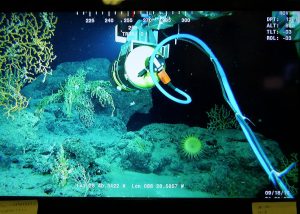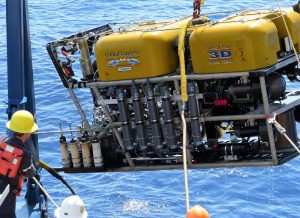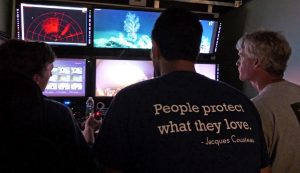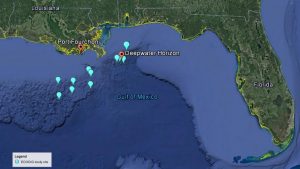Science at Sea: Researchers Monitor Marine Ecosystems Near Deepwater Horizon
– JUNE 6, 2017
Follow Along Starting June 12!
A 12-day science expedition on the exploration vessel Ocean Intervention II embarks June 11 to investigate how oil, gas, and chemical dispersants affect marine life and their environment deep in the Gulf of Mexico. Scientists and outreach personnel onboard the vessel will interact with the public and school-age children using streaming video, social media, and question-and-answer sessions.
Researchers with the Ecosystem Impacts of Oil and Gas to the Gulf (ECOGIG) consortium are studying how deep water ecosystems respond to natural seafloor seeps of oil and gas and are monitoring areas affected by the Deepwater Horizon oil spill. They want to better understand how processes normally work to help inform management response to out-of-the norm circumstances such as an oil spill. This expedition will continue their annual monitoring around the spill site that began in 2010.
“Large oil and gas injections to an ecosystem, such as that resulting from the Deepwater Horizon oil well blowout, cause both immediate (acute) and long term (chronic) impacts,” said ECOGIG project director Samantha Joye of the University of Georgia. “This upcoming research expedition is a critical component of ECOGIG’s long term monitoring program and complements our efforts to track impacts in the pelagic and other benthic aspects of the Gulf system and contributes to some of our core work documenting the microbiomes of the deep Gulf.”
Led by chief scientist Iliana Baums of Pennsylvania State University and dubbed Jewels of the Gulf: Deepwater Expedition, this research will focus on corals and sediment-dwelling animals and their surrounding environments in seafloor sediments and the water column. Teams will monitor the distribution and abundance of meiofauna (small benthic invertebrates) in relation to natural seeps and will conduct analyses to better understand the genetic structure of deep sea corals.
Using a remotely operated vehicle (ROV Global Explorer) at 1,000+ meters equipped with high-resolution cameras, the team will capture hundreds of coral images. Researchers will then analyze these photographic data and compare with imagery from prior expeditions to document the spill’s impacts and improve understanding of the mechanisms that influence coral recovery and survival. Teams will also collect live corals for laboratory-based experiments that analyze tolerance and response to oil and dispersant contained in marine snow. Sinking marine oil snow is one of the mechanisms that impacted deep sea fauna during and after the Deepwater Horizon spill.
“Continued monitoring is critical,” said project co-leader Chuck Fisher of Pennsylvania State University. “After seven years, the 500-year old corals are still recovering from the effects of the spill and their ultimate fate is still not known. A lot remains to be learned about these amazing and beautiful animals.”
A live ROV camera feed will be accessible throughout the expedition at ecogig.org. School children and summer campers across the U.S. will interact with scientists during live question and answer sessions. Also, in collaboration with Mission Blue, an interactive Facebook Live video hosted by Ocean Allison will be broadcast to a worldwide audience.
“The outreach component of this expedition is particularly exciting,” said Joye. “Communicating with kids and the public at large about the wonders of the Gulf’s deep sea ecosystems and the relevance of this research is important.”
Institutions participating in this expedition include Pennsylvania State University, Temple University, Lehigh University, University of Georgia, and the U.S. Geological Survey.
Stay up to date on the research in real time by following along via ECOGIG’s Facebook, Twitter, and Instagram channels. Additional content including educational videos, podcasts and a documentary short film will become available after the expedition.
Read more about this ongoing research:
- Grad Student Girard Uses High-Definition Imagery to Assess Post-Spill Coral Recovery
- Grad Student Dannenberg is Unlocking Mysteries of Deepwater Coral Communities
- Grad Student Johansen Counts Bubbles to Understand Natural Oil Seeps
- Grad Student Rogers Traces Gulf Oil as Scientific CSI
- Study Suggests Brittle Stars Limited Deepwater Horizon Impacts on Deep Sea Corals
- Study Shows Extended Footprint of Oil Spill Impact on Corals
************
This research was made possible in part by a grant from the Gulf of Mexico Research Initiative (GoMRI) to the Ecosystem Impacts of Oil and Gas Inputs to the Gulf-2 (ECOGIG-2) consortium.
The Gulf of Mexico Research Initiative (GoMRI) is a 10-year independent research program established to study the effect, and the potential associated impact, of hydrocarbon releases on the environment and public health, as well as to develop improved spill mitigation, oil detection, characterization and remediation technologies. An independent and academic 20-member Research Board makes the funding and research direction decisions to ensure the intellectual quality, effectiveness and academic independence of the GoMRI research. All research data, findings and publications will be made publicly available. The program was established through a $500 million financial commitment from BP. For more information, visit https://gulfresearchinitiative.org/.
© Copyright 2010-2017 Gulf of Mexico Research Initiative (GoMRI) – All Rights Reserved. Redistribution is encouraged with acknowledgement to the Gulf of Mexico Research Initiative (GoMRI). Please credit images and/or videos as done in each article. Questions? Contact web-content editor Nilde “Maggie” Dannreuther, Northern Gulf Institute, Mississippi State University (maggied@ngi.msstate.edu).









